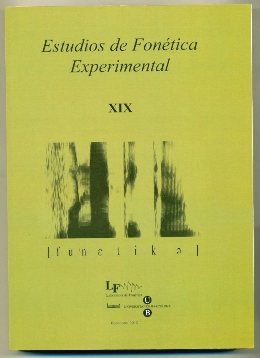Equivalencias melódicas entre los tonos del chino mandarín y la entonación española
Keywords:
Spanish intonation, Chinese tones, prosodic patterns, L2Abstract
Current research on intonation show that several phonetic (particularly, prosodic) landmarks exist that indicate a pattern of intonational change at the end of intonation phrases, which change and can be distinguished by means of a series of grammatical and expressive variables (Cantero, 2002; Garrido et alii, 2004; Hidalgo, 2006; T’Hart et alii, 1990). The prosodic similarities between the prosodic patterns of Mandarin Chinese words and the intonational phrases of Spanish allows us to build a series of equivalences between Chinese tones and the functions of Spanish intonation.
References
AO, B. (1992): «The Non-uniqueness Condition and the Segmentation of the Chinese Syllable», Working Papers in Linguistic, 42, pp. 1-25.
BOERSMA, P. y D. WEENINK (1992-2007): PRAAT. Doing phonetics by computer. Univerty of Amsterdam, Institue of Phonetic Sciences, http://www.praat.org.
DUANMU, S. (2000): The Phonology of Standard Chinese, Oxford, University Press.
CANTERO SERENA, F. J. (2002): Teoría y análisis de la entonación, Barcelona, Universitat de Barcelona.
CANTERO SERENA, F. J. y D. FONT ROTCHÉS (2009): «Protocolo para el análisis melódico del habla», Estudios de Fonética Experimental, XVIII, pp.17-32.
FONT ROTCHES, D. (2008) : «Els patrons entonatius de les interrogatives absolutes del catalá central», Llengua & Literatura, 19, pp.299-329.
ESCANDELL VIDAL, M. V. (1999): «Los enunciados interrogativos. Aspectos semánticos y pragmáticos», en I. Bosque y V. Demonte (eds.): Gramática Descriptiva de la Lengua Española, Madrid, Espasa, vol 3, cap. 61. pp. 3929-3991.
ESCANDELL VIDAL, M. V. (2006): Introducción a la pragmática, Madrid, Ariel Lingüística.
GARRIDO ALMIÑANA, J. M. (2001): «La estrucura de las curvas melódicas del español: propuesta de modelización», Lingüística Española Actual, 23, 2, pp. 173-209.
GARRIDO, J. M; J. LLISTERRI; R. MARÍN; C. DE LA MOTA y A. RÍOS (2004): «Prosodic markers at syntactic boundaries in Spanish», Proceedings of the XIIIth International Congress of Phonetic Sciences, vol 2, pp. 370-373.
GIL FERNÁNDEZ, J. (2007): Fonética para profesores de español: de la teoría a la práctica, Madrid, Arco.
HIDALGO, A. (2006): Aspectos de la entonación española: viejos y nuevos enfoques, Madrid, Arco.
LIN, Y.H. (2007): The sounds of chinese, Cambridge, Cambridge University Press.
PLANAS MORALES, S. y X. VILLALBA (2007): «Las similitudes en el contorno entonativo de las palabras del chino mandarín y de los grupos fónicos en español» en E. Balmaseda Maestu (ed.): Las destrezas orales en la enseñanza del español L2-LE, vol.II, Logroño, Publicaciones de la Universidad de la Rioja, pp.901-314.
T’HART, J; R. COLLIER, R. y A. COHEN (1990): A perceptual study of intonation. An experimental-phonetic approach to speech melody, Cambridge, Cambridge University Press.
TRASK, R. L. (1996): A Dictionay of Phonetics and Phonology, Londres, Routledge.
YIP M. (1994): «Isolated Uses of Prosodic Categories», en J. Cole y C. Kisseberth (eds.): Perspectives in Phonology, CSLI Lecture Notes, 51, pp. 293-311.
YIP P.C. y D. RIMMINGTON (2004): Chinese: a Comprehensive Grammar, Londres, Routledge.
Downloads
Published
How to Cite
Issue
Section
License

This work is licensed under a Creative Commons Attribution-NonCommercial-NoDerivatives 4.0 International License.
All articles published online by Estudios de Fonética Experimental are licensed under Creative Commons Attribution-NonCommercial-NoDerivs 4.0 International (CC BY-NC-ND 4.0 DEED), unless otherwise noted. Estudios de Fonética Experimental is an open access journal. Estudios de Fonética Experimental is hosted by RCUB (Revistes Científiques de la Universitat de Barcelona), powered by Open Journal Systems (OJS) software. The copyright is not transferred to the journal: authors hold the copyright and publishing rights without restrictions. The author is free to use and distribute pre and post-prints versions of his/her article. However, preprint versions are regarded as a work-in-progress version used as internal communication with the authors, and we prefer to share postprint versions.




